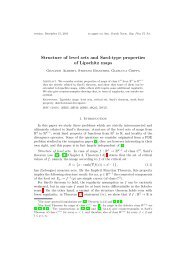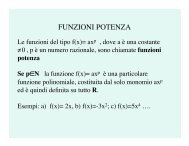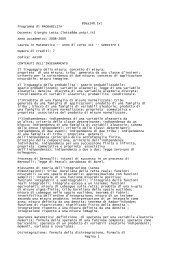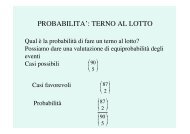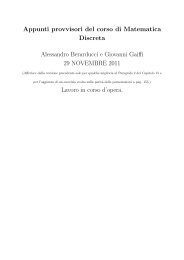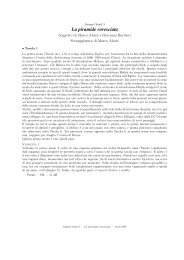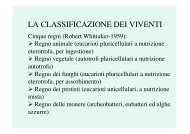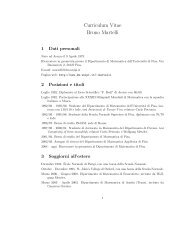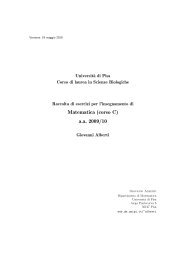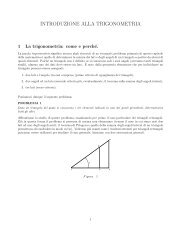Immersioni aperte in dimensione infinita - Dipartimento di Matematica
Immersioni aperte in dimensione infinita - Dipartimento di Matematica
Immersioni aperte in dimensione infinita - Dipartimento di Matematica
You also want an ePaper? Increase the reach of your titles
YUMPU automatically turns print PDFs into web optimized ePapers that Google loves.
2.2 Mappe <strong>di</strong> Fredholm <strong>di</strong> <strong>in</strong><strong>di</strong>ce zero proprie e limitate 27<br />
Siccome V a ⊂ Vx per qualche x ∈ M, essendo V ′ ⊂ U ′ e qu<strong>in</strong><strong>di</strong> Vx ⊂ Ux, si ha che per ogni i <strong>in</strong><br />
{1, . . . , k}, x(bi), y ∈ Ux × Ux, (2.2.13)<br />
e qu<strong>in</strong><strong>di</strong> (cfr. 2.2.3), per ogni i ∈ {1, . . . , k}, G −1 è def<strong>in</strong>ita su (x(bi), y) e la (2.2.10) def<strong>in</strong>isce<br />
correttamente la nostra mappa f. Chiaramente f def<strong>in</strong>ita dalla (2.2.10) è <strong>di</strong> classe C ∞ .<br />
Verifichiamo che f è Fredholm <strong>di</strong> <strong>in</strong><strong>di</strong>ce zero. Nella carta V ′ corrispondente a Vx, il <strong>di</strong>fferenziale<br />
<strong>di</strong> f nel punto y ′ <strong>di</strong> V ′ è (cfr. eq. (2.2.4))<br />
dfy ′ =<br />
k<br />
µbi (y′ ) d h x ′ (bi), · <br />
y ′ + <br />
π2 ◦ g ◦ G −1 x ′ (b), y ′ d(µb)y ′[ · ]. (2.2.14)<br />
i=1<br />
b<br />
Il primo term<strong>in</strong>e è <strong>in</strong> Φ0(H) perché (∀i ∈ {1, . . . , k}) (x ′ (bi), y ′ ) ∈ V ′ ×V ′ , dunque per la (2.2.7)<br />
k<br />
µbi(y ′ ) d h x ′ (bi), · <br />
y ′ =<br />
i=1<br />
Il secondo term<strong>in</strong>e<br />
k<br />
i=1<br />
w ∈ H ↦−→ <br />
b<br />
µbi(y ′ ) ∂h<br />
∂v ′ (x′ (bi), y ′ ) ∈ conv ∂h/∂v ′ (V ′ × V ′ ) ⊂ Φ0(H).<br />
π2 ◦ g ◦ G −1 x ′ (b), y ′ d(µb)y ′[w] ∈ R<br />
è un operatore <strong>di</strong> rango f<strong>in</strong>ito. Qu<strong>in</strong><strong>di</strong> dfy ′ è un operatore l<strong>in</strong>eare Fredholm <strong>di</strong> <strong>in</strong><strong>di</strong>ce zero. Segue<br />
che f è una C∞-Φ0-mappa. Osservazione 2.25. La formula 2.2.10 che def<strong>in</strong>isce la mappa f congiuntamente con l’equazione 2.2.13<br />
suggeriscono che, a meno <strong>di</strong> scegliere banalizzazioni locali per T M <strong>in</strong> un <strong>in</strong>torno della sezione nulla<br />
con carte banalizzanti sufficientemente piccole (si osservi che la mappa G applica la sezione nulla<br />
<strong>di</strong> T M nella <strong>di</strong>agonale ∆ ⊂ M × M, <strong>in</strong>oltre essa assume i propri valori <strong>in</strong> un <strong>in</strong>torno <strong>di</strong> ∆), nella<br />
<strong>di</strong>mostrazione appena conclusa si può fare a meno <strong>di</strong> <strong>in</strong>vocare il teorema <strong>di</strong> Kuiper e qu<strong>in</strong><strong>di</strong> della<br />
mappa <strong>di</strong> banalizzazione globale g : T M → M × H.<br />
Dunque, <strong>in</strong> particolare, con questa osservazione la <strong>di</strong>mostrazione del teorema 2.24 che abbiamo<br />
presentato ben si adatta anche al caso <strong>in</strong> cui la varietà sia modellata su uno spazio <strong>di</strong> Banach reale <strong>di</strong><br />
<strong><strong>di</strong>mensione</strong> <strong>in</strong>f<strong>in</strong>ita, dotato <strong>di</strong> una base <strong>di</strong> Schauder e <strong>di</strong> partizioni dell’unità <strong>di</strong> classe C ∞ (si ricor<strong>di</strong><br />
che per gli spazi <strong>di</strong> Banach non c’è un analogo del teorema <strong>di</strong> Kuiper). Nella generalità Banach,<br />
<strong>in</strong> particolare, anziché fissare una struttura Riemanniana all’<strong>in</strong>izio della <strong>di</strong>mostrazione avremmo<br />
avuto cura <strong>di</strong> considerare uno spray, la cui esistenza (cfr. teorema F.8) è garantita dall’esistenza <strong>di</strong><br />
partizioni dell’unità sulla varietà.<br />
Osservazione 2.26. Come caso particolare del corollario G.7, si ha che, per ogni x <strong>in</strong> M, l’immag<strong>in</strong>e<br />
dfx(TxM) <strong>di</strong> TxM me<strong>di</strong>ante dfx è un sottospazio chiuso <strong>di</strong> T f(x)H = H.<br />
Ogni mappa <strong>di</strong> Fredholm è localmente propria, come provato nel teorema E.10. Mostreremo<br />
adesso come ottenere a partire da una mappa <strong>di</strong> Fredholm <strong>di</strong> <strong>in</strong><strong>di</strong>ce zero una mappa propria<br />
Fredholm <strong>di</strong> <strong>in</strong><strong>di</strong>ce zero.<br />
Lemma 2.27. Sia M uno spazio metrico, H uno spazio <strong>di</strong> Hilbert, ed f : M → H una applicazione<br />
cont<strong>in</strong>ua propria. Se k : M → H è una mappa cont<strong>in</strong>ua tale che la chiusura <strong>di</strong> k(M) <strong>in</strong> H è un<br />
sotto<strong>in</strong>sieme compatto ( 2 ) allora f + k : M → H è una mappa propria.<br />
Dimostrazione. Sia K ⊂ H un compatto. Si deve provare che, posta g := f + k, g −1 (K) ⊂ M è un<br />
<strong>in</strong>sieme compatto. Per questo scopo osserviamo che<br />
g −1 (K) ⊂ f −1 K − k(M) , (2.2.15)<br />
2 Una mappa con questa proprietà è chiaramente una mappa compatta, <strong>in</strong>fatti (∀B ⊂ M) k(B) ⊂ k(M): ora k(B)<br />
è un chiuso, k(M) è compatto per ipotesi, dunque k(B) è un compatto perché chiuso <strong>in</strong> un compatto. In particolare<br />
questo può essere ripetuto quando B è limitato.<br />
RAUL TOZZI



